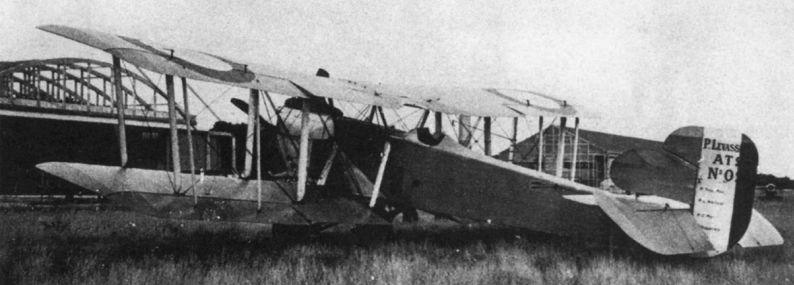Levasseur PL 2
Следующей разработкой стал одноместный бомбардировщик-торпедоносец PL 2.01 (по классификации - AT.1). Он стал первым в серии машин, спроектированных Левассером для морской авиации. Этот биплан, слегка напоминавший британские "Blackburn", впервые взлетел в ноябре 1922 года. На PL 2.02 установили четырехлопастный винт и внесли еще ряд доработок в силовую установку, после чего в 1923 году последовала серия из девяти машин, оснащавшихся надувными баллонетами и сбрасывающимся шасси для авариной посадки на воду. В 1926 году из этих самолетов сформировали эскадрилью 7B2, начавшую службу на авианосце "Беарн". Последние PL 2 были списаны в 1932 году. Серийные самолеты имели размах крыла 15,15 м и оснащались 580-сильными (433 кВт) двигателями Renault 12Ma. Максимальная взлетная масса достигала 3653 кг, а скорость - 180 км/ч. Вооружение состояло из 450-кг торпеды или бомб соответствующей массы и одного 7,7-мм пулемета.
Показать полностьюShow all
Flight, December 1921
The Paris Aero Show - 1921
PIERRE LEVASSEUR
17 to 21, Place Felix-Faure, Paris (XVe)
FOR sheer excellence of workmanship and beauty of finish no stand can excel that of Pierre Levasseur, whose Directeur, M. Charles Frechet, was attached to the British Air Ministry during the War. In addition to two aeroplanes, there are specimens of propeller work which are a joy to behold. One of the complete machines, shown in skeleton, is a torpedo-plane, and is very reminiscent of the Blackburn "Swift" - so much so that one wonders if, perchance, it should be built under licence. The front portion of its fuselage is a steel tube structure of very clean design and, needless to say, splendid workmanship. It detaches from the main fuselage structure as a complete unit, with its 600 h.p. Renault engine. The under-carriage is of the divided type, to allow of dropping the torpedo suspended between its two halves, and is also of steel, with rubber pads working in compression for its shock-absorbing gear. The rest of the machine is of usual wood and metal clip and wire construction, and is in every way up to the best of British practice.
Показать полностьюShow all
Flight, January 1923
THE PARIS AERO SHOW 1922
PIERRE LEVASSEUR, Paris
ONE of the first, if not actually the first, French firms to take up the design and construction of torpedo planes was that of Pierre Levasseur, whose managing director is M. Charles Frechet. It is not, therefore, surprising that again this year one of the machines exhibited was a torpedo plane, while the second was a Navy type biplane, fitted with an undercarriage whose axle and wheels can be dropped if the machine has to alight on the sea. In addition to the complete machines P. Levasseur exhibited several examples of the variable pitch airscrews which this firm has developed during the last few years.
The torpedo plane resembles in general outline the Blackburn "Swift," and, as a matter of fact, we believe that there is some working arrangement between the two firms by which the experience of one is made available to the other. Thus the P. Levasseur torpedo plane is obviously modelled upon, rather than slavishly copied from, the Blackburn machines, and conversely, we understand that the P. Levasseur variable pitch airscrews are being handled in this country by the Leeds firm. Having stated this, there is little need to go into great detail regarding the Levasseur torpedo plane, type A.T.1. The machine is largely constructed of steel tubing, the engine mounting and front portion of the fuselage being of this material. The engine fitted is a 600 h.p. Renault, and a wide speed range has been aimed at, not only in order that the machine may land more easily on the deck of an aircraft carrier, but also to facilitate the aiming and dropping of the torpedo. Needless to say, a divided undercarriage is provided in view of the torpedo carried, and flotation gear ensures that the machine will float if forced to come down on the sea.
The main characteristics are as follows: Length, o.a., 10-65 m. (35 ft.); span 15-25 m. (50 ft.); wing area 72 sq. m. (775 sq. ft.); weight empty, 2,150 kgs. (4,750 lbs.); useful load 1,150 kgs. (2,530 lbs.); total loaded weight 3,300 kgs. (7,280 lbs.); wing loading 45-5 kgs./sq. m. (9-4 lbs./sq.ft.); power loading 6 kgs./h.p. (12-15 lbs./h.p.). Maximum speed, 160 km. (99 m.p.h.); slow speed, 85km. (52-7 m.p.h.).
<...>
Показать полностьюShow all





